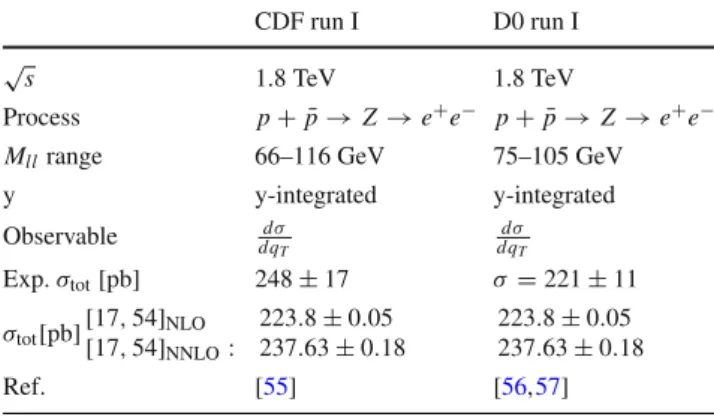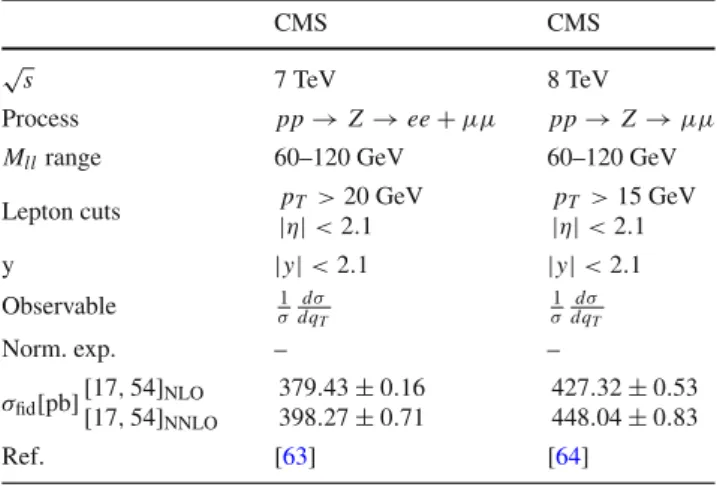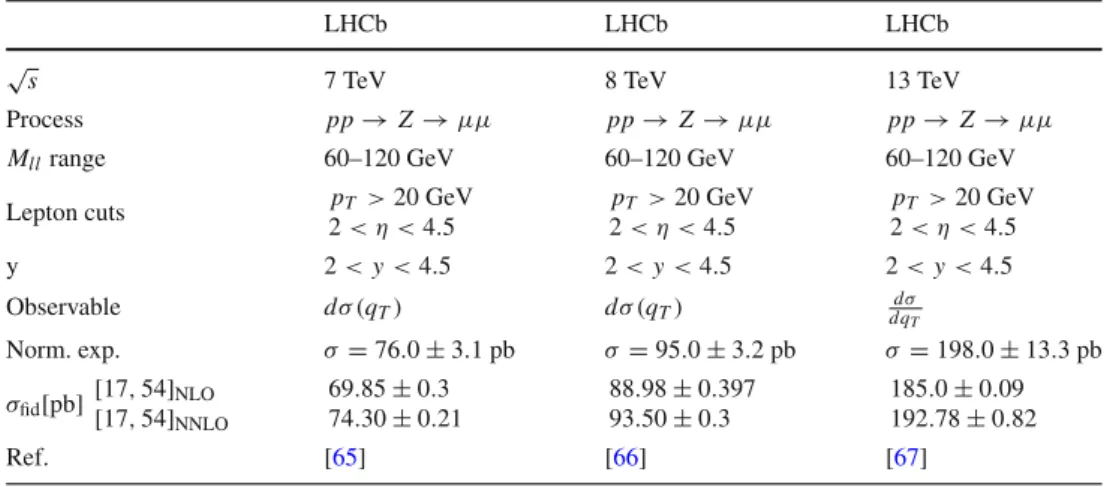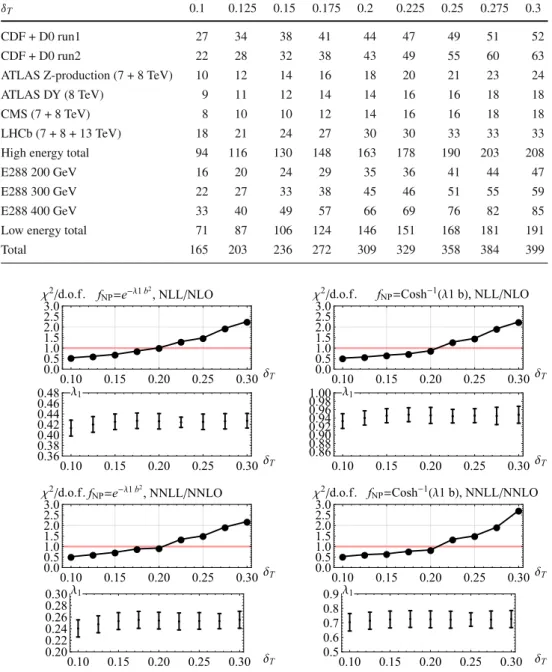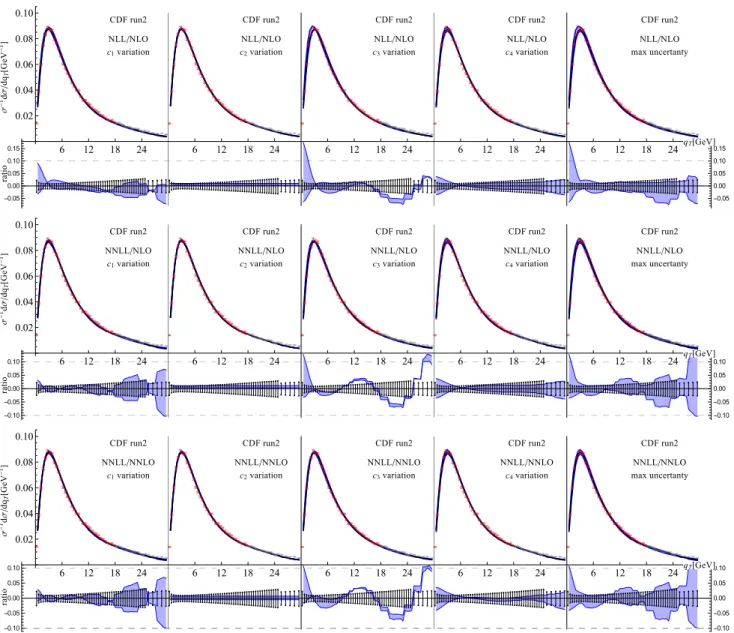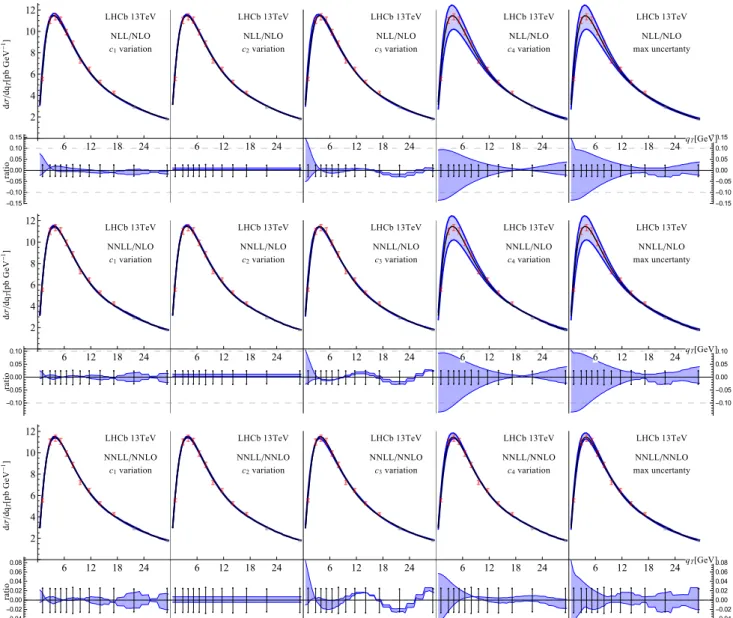Regular Article - Theoretical Physics
Analysis of vector boson production within TMD factorization
Ignazio Scimemi 1,a , Alexey Vladimirov 2
1
Departamento de Física Teórica, Universidad Complutense de Madrid, Ciudad Universitaria, 28040 Madrid, Spain
2
Institut für Theoretische Physik, Universität Regensburg, 93040 Regensburg, Germany
Received: 23 November 2017 / Accepted: 15 January 2018
© The Author(s) 2018. This article is an open access publication
Abstract We present a comprehensive analysis and extrac- tion of the unpolarized transverse momentum dependent (TMD) parton distribution functions, which are fundamental constituents of the TMD factorization theorem. We provide a general review of the theory of TMD distributions, and present a new scheme of scale fixation. This scheme, called the ζ -prescription, allows to minimize the impact of pertur- bative logarithms in a large range of scales and does not gen- erate undesired power corrections. Within ζ -prescription we consistently include the perturbatively calculable parts up to next-to-next-to-leading order (NNLO), and perform the global fit of the Drell–Yan and Z-boson production, which include the data of E288, Tevatron and LHC experiments. The non-perturbative part of the TMDs are explored checking a variety of models. We support the obtained results by a study of theoretical uncertainties, perturbative convergence, and a dedicated study of the range of applicability of the TMD fac- torization theorem. The considered non-perturbative models present significant differences in the fitting behavior, which allow us to clearly disfavor most of them. The numerical evaluations are provided by the arTeMiDe code, which is introduced in this work and that can be used for current/future TMD phenomenology.
1 Introduction
The transverse momentum dependent (TMD) distributions are universal functions that describe the interactions of par- tons in a hadron. The TMD distributions naturally appear within the TMD factorization theorem for the differential cross section of double-inclusive hard processes. A lot of effort has been made to achieve a comprehensive picture of TMD factorization (for the latest works see [1–8]). In this work we perform a detailed comparison of the experimen- tal measurements with the theory expectations based on our
a
e-mail: ignazios@fis.ucm.es
studies of higher-order perturbative expansions and power corrections for unpolarized TMDPDFs made in Refs. [9–12].
Among many different spin (in)dependent TMD distri- butions, the unpolarized TMD parton distribution functions (TMDPDFs) play a central role. From the practical point of view, their precise knowledge is required to extract fur- ther TMD distributions and perform other precision mea- surements. The ideal process to study the unpolarized TMD- PDFs is the unpolarized vector boson production. The data on the q T -dependent cross-section for the Drell–Yan pro- cess are collected by many experiments, including the pre- cise measurements done by Tevatron and LHC. The theo- retical descriptions of Drell–Yan data were made by many groups using different forms of TMD factorization (see e.g.
[8,13–22]).
This work presents a number of differences with respect to the previous literature. The collection of the improve- ments forms a completely new point of view in the TMD phenomenology. The main difference of the present work with respect to the more standard ones (here we consider as the most spread out, and de facto standard, analyses those based on the codes ResBos [15,23] and DYqT/DYRes [17,18,21]) are as follows: (i) We extract the parameters related to individual TMDPDFs, which are suitable for phe- nomenological description of other TMD-related processes.
(ii) We consistently include the perturbative ingredients, such as coefficient functions and anomalous dimensions, at the next-to-next-to-leading order (NNLO), introducing and using the ζ -prescription to solve the problem of perturbative convergence at large-b (where b is the transverse distance).
(iii) The TMDPDF parameterization is based on and is con-
sistent with the theory expectation on the TMD behavior with
b. To our knowledge this is the first attempt to include in a
fit both high and low energy data at NNLO precision. The
extraction of TMDs takes into account (for the first time to
our knowledge) also LHC data. All this represents for us a
clear improvement with respect to the more classical analy-
ses.
In a modern view, a TMD distribution is a cumbersome function of many factors, which mix up perturbative and non- perturbative information. In this context, the issue of the sep- aration of perturbative and non-perturbative physics requires a fine analysis and it is open to different solutions. The ζ - prescription proposed in this work, is an attempt to consider the perturbative input to a TMD distribution as it is, with- out artificial regulators. The ζ -prescription is founded on the fact that the TMD factorization introduces two factorization scales, one for the collinear and one for the soft exchanges.
These scales are usually fixed to the same point, while in the ζ -prescription they are chosen to eliminate the problematic double-log contributions. In other words, the ζ -prescription is based on the freedom to select the normalization and fac- torization scales, which is guaranteed by the structure of the perturbative theory. The ζ -prescription is essentially differ- ent from other used schemes. In particular, it does not strictly solve the problem of the large logarithmic contributions at large-b. It only decreases the power of the logarithmic con- tributions. However, the x-dependence of the remaining log- arithmic terms has a form which prevents the blow up of the perturbative series, which is not accidental, but the result of the charge conservation. In this way, the ζ -prescription post- pones the large logarithm problem to the very far domain of b-space, where other factors suppress a TMD distribution.
The practical implementation of the ζ -prescription shows that it is efficacious and it allows a very accurate and sound description of the data.
The description of the non-perturbative parts of TMD dis- tributions is the most interesting task. It is highly non-trivial because the definition of the non-perturbative part is strongly affected by schemes and prescriptions used in the perturba- tive implementation. In this respect a full NNLO can be clar- ifying. As an example, we recall that the non-perturbative behavior of the TMDPDFs is often assumed to have a Gaus- sian shape (see e.g. discussions in [15,22,24,25]). Although the Gaussian ansatz is widely used, it comes into conflict with the usual picture of long-distance strong interaction fueled by light-meson exchanges. The typically expected behav- ior at long distances is exponential, which is confirmed also by model calculations [26]. However, the Gaussian shape is often introduced together with the b ∗ -prescription [27].
Notwithstanding many positive features, the b ∗ -prescription has a serious issue: it introduces undesired b-even power cor- rections. In turn, these power correction introduced by b ∗ can easily simulate the Gaussian behavior (see also discussion in [28]). Once the b ∗ -prescription is removed the Gaussian ansatz for the TMD shape is no more essential, according to what we find.
An additional remarkable point of the present study is the wide range of energies covered by the data that we have analyzed. The lowest energy measurements included in the fits have (Q, √
s) = (4, 19.4) GeV (E288 experiment [29]),
while the most energetic have (Q, √
s) = (116 − 150, 8 · 10 3 ) GeV (ATLAS collaboration [30]). Typically, the low- and high-energy data are considered separately. The main reason for a separate scan is the assumed physical picture of strong interactions, which describes different energies. The description of the high-energy data requires a precise per- turbative input and it is expected to be less sensitive to the fine non-perturbative dynamics. The situation is the opposite for the low-energy measurements. Our experience shows that the inclusion of data of different energies is not only possi- ble within the TMD formalism, but it is also desired because it cuts away inappropriate models very sharply. We find also that the precision achieved by LHC is already sensitive enough to the non-perturbative structure of TMDs. We show that low and high energy data are sensitive to different regions of b-space, and consequently to different non-perturbative regimes of the TMDs: high energy data are better described by a Gaussian non-perturbative correction, while low energy data prefer an exponential type of non-perturbative models.
The code (arTemiDe) that we have prepared allows to test all these hypotheses, and can be adaptded also to test different non-perturbative inputs for TMDs.
In order to extract the non-perturbative core of the TMDs, in the present study we choose a neutral tactic. We have scanned many possibilities such as a Gaussian and exponen- tial behavior, with/without inclusion of power corrections, and so on. We have also studied the non-perturbative cor- rection to the evolution kernel. During the examination of models we have prioritized the following criteria:
(i) Stability The TMD factorization is valid at small-q T
(the dilepton transverse momentum) up to a certain limit. Therefore, an acceptable model should produce a stable and good description within the allowed q T - range. In other words, the value of χ 2 should be suffi- ciently close to one and the central values of the param- eters should be stable independently of the number of included data points (as far as the points belong to the allowed range).
(ii) Convergence The agreement with data should improve with the increase of the perturbative order. Given the current state of the art of the theory, we can define four successive perturbative orders, which is enough to test the perturbative convergence. Also, the value of the phenomenological non-perturbative constants that one extracts should converge to some central value.
(iii) χ 2 minimization Naturally, among the models with sim-
ilar behavior we select the model with the minimal χ 2 .
We have found that it is difficult to find a model (with one
or two parameters), which fulfills the demands (i) and
(ii), and that at the same time provides a good χ 2 value
on the whole set of data points (although it is relatively
easy to achieve this, selecting a particular experiment).
The models that we test consider a kind of minimal set of parameters which can be enlarged in future studies, refining the fitting hypotheses.
In the present fit, we have included the measurements of E288 at low-energies, Z-boson production at CDF, D0, ATLAS, CMS and LHCb, and Drell–Yan measurements from ATLAS.
To our knowledge, this is the largest set of Drell–Yan data points ever simultaneously considered in a fit within the TMD formalism. We find also that the LHC data below the Z-boson peak and at small q T are very important for current/future TMD studies. In the article we present the most successful models that we have found, and discuss some popular models.
In order to numerically evaluate the theoretical expres- sions, we have produced the package arTeMiDe.
arTeMiDe has a flexible module structure and can be used at any level of TMD theory description, from the evaluation of a single TMDPDF or evolution factor to an evaluation of differential cross-section. The arTeMiDe code is available at [31] and can be used to check our statements or test a possible future/alternative ansatz (for instance [14,32]). In arTeMiDe we have collected all recent achievements of TMD theory, including NNLO matching coefficient func- tion, and N 3 LO TMD anomalous dimensions. In the current version, arTeMiDe evaluates only unpolarized TMDPDFs and related cross-sections, however, we plan to extend it fur- ther.
The body of the article is divided as in the following. In Sect. 2 we review the theoretical construction of the Drell- Yan cross section and summarize the theoretical knowledge on unpolarized TMDPDFs. In this section, we also describe all the theoretical improvements which are original for this work. The main original point, namely ζ -prescription is pre- sented in Sect. 2.4 and “Appendix B”. The phenomenological studies are presented in Sect. 3. This section includes also a dedicated discussion of the shape of the non-perturbative part of the TMD. The allowed range of validity of the TMD factor- ization is explored in Sect. 3.4, the presentation of theoretical uncertainties is given in Sect. 3.5. The results of the final fit are presented in Sect. 3.7. A final discussion and conclusions can be found in Sect. 4.
2 Theoretical framework
We consider the Drell–Yan reaction h 1 + h 2 → G(→ ll ) + X, where G is the electroweak neutral gauge boson, γ ∗ or Z . The incoming hadrons have momenta p 1 and p 2 with ( p 1 + p 2 ) 2 = s. The gauge boson decays to the lepton pair with momenta k 1 and k 2 . The momentum of the gauge boson or equivalently the invariant mass of lepton pair is Q 2 = q 2 = ( k 1 + k 2 ) 2 . The differential cross-section for the Drell–
Yan process can be written in the form [33,34]
d σ = d 4 q 2s
G , G
=γ, Z
L μν GG
W μν GG
Δ G (q )Δ G
(q ), (1) where 1/2s is the flux factor, Δ G is the (Feynman) propagator for the gauge boson G. The hadron and lepton tensors are respectively
W μν GG
=
d 4 z ( 2 π) 4 e − i q z
× h 1 ( p 1 )h 2 (p 2 )|J μ G (z)J ν G
(0)|h 1 ( p 1 )h 2 (p 2 ), (2) L GG μν
=
d 3 k 1
(2π) 3 2 E 1
d 3 k 2
(2π) 3 2 E 2 ( 2 π) 4 δ 4 ( k 1 + k 2 − q )
× l 1 (k 1 )l 2 (k 2 )|J ν G (0)|00| J μ G
(0)|l 1 (k 1 )l 2 (k 2 ), (3) where J μ G is the electroweak current.
The point of our interest is the q T dependence of the cross-section, where q T is the transverse component of the produced gauge boson in the center-of-mass frame. More precisely, we are interested in the regime q T Q, where the TMD factorization formalism can be applied. Within the TMD factorization, one obtains the following expression for the unpolarized hadron tensor (see e.g. [35])
W μν GG
= −g T μν
π N c
|C V (q, μ)| 2
f , f
z GG f f
d 2 b
4π e i ( q b )
× F f ← h
1(x 1 , b; μ, ζ 1 )F f
← h
2(x 2 , b; μ, ζ 2 )+Y μν , (4) where g T is the transverse part of the metric tensor and the summation runs over the active quark flavors. The variable μ is the hard factorization scale. The variables ζ 1 , 2 are the scales of soft-gluons factorization, and they fulfill the rela- tion ζ 1 ζ 2 Q 4 . In the following, we consider the symmetric point ζ 1 = ζ 2 = ζ = Q 2 . The variables x 1 , 2 are the longitu- dinal parts of parton momenta
x 1 =
Q 2 + q T 2
√ s e y Q
√ s e y ,
x 2 =
Q 2 + q T 2
√ s e − y Q
√ s e − y . (5)
The factors z GG f f
are the electro-weak charges and they are
given explicitly in Sect. 2.1. The factor C V is the match-
ing coefficient of the QCD neutral current to the same cur-
rent expressed in terms of collinear quark fields. The explicit
expressions for C V can be found in [36–38], and are also
given in “Appendix A”. The functions F f ← h are the unpolar-
ized TMDPDFs for quark f in the hadron h. They are uni-
versal non-perturbative functions and the main objects of our study. The details of their definition and their parametriza- tion are given in Sect. 2.3. Finally, the term Y denotes the power corrections to the TMD factorization theorem (to be distinguished from the power corrections to the TMD oper- ator product expansion). The Y -term is of the order q T /Q and composed of TMD distributions of the higher dynamical twist. In our study, we restrict ourself to the limit of low q T
such that the Y -term can be dropped.
Evaluating the lepton tensor, and combining together all factors one obtains the cross-section for the unpolarized Drell–Yan process at leading order of the TMD factoriza- tion, in the form [1,2,6,39–41]
d σ
d Q 2 d yd ( q T 2 ) = 4π 3N c
P s Q 2
GG
z ll GG
(q )
f f
z GG f f
|C V (q , μ)| 2
× d 2 b
4π e i ( bq ) F f ← h
1(x 1 , b; μ, ζ )
×F f
← h
2(x 2 , b; μ, ζ ) + Y, (6) where y is the rapidity of the produced gauge boson. The factorP is a part of the lepton tensor and contains information on the fiducial cuts. It is discussed in details in Sect. 2.6. In the rest of this section a more detailed description of the particular components is presented.
2.1 Expressions for cross-section for different produced bosons
In the case of neutral vector bosons production, the sum over G and G in Eq. (6) has three terms
d σ
d Q 2 d yd ( q T 2 ) = d σ γ γ
d Q 2 d yd ( q T 2 ) + d σ Z Z d Q 2 d yd ( q T 2 ) + d σ γ Z
d Q 2 d yd ( q 2 T ) , (7) which correspond to γ ∗ -production, Z -production and inter- ference of γ ∗ -Z production amplitudes. These three terms of the cross-sections differ from each other only due to the factors z GG f f
in Eq. (6), which are
z γ γ ll
z γ γ f f
= δ f f ¯ α 2 em (Q)e 2 f , z ll Z Z
z Z Z f f
= δ f f ¯ α 2 em (Q)Q 4
(Q 2 − M 2 Z ) 2 + Γ Z 2 M Z 2
1 − 4s 2 W + 8s W 4 8s W 2 c 2 W
× 1 − 4|e f |s W 2 + 8e 2 f s W 4 8s W 2 c 2 W
z ll Z
γ z Z f f γ
+ z γ ll
Z z γ f f Z
= δ f f ¯ α em 2 (Q)2 Q 2 (Q 2 −M Z 2 ) (Q 2 − M 2 Z ) 2 + Γ Z 2 M 2 Z
1 − 4s W 2 4s W c W
× |e f |(1 − 4|e f |s 2 W )
4s W c W , (8)
where M Z and Γ Z are the mass and the width of the Z-boson, s W and c W are sine and cosine of the Weinberg angle. We use the following of values [42]
M Z = 91.2 GeV, Γ Z = 2.5 GeV, s W 2 = 0.2313. (9) In many studies (see e.g.[15,19,20,22,43]) the contribution of γ ∗ to the cross-section is neglected in the vicinity of the Z- peak, i.e. the zero-width approximation is used. Here, instead, we include the γ ∗ and interference terms in the evaluation of the the cross-section. The inclusion of these terms is impor- tant for LHC (in particular ATLAS experiment), where the measurement precision often exceeds the theory precision.
2.2 TMD parton distributions: evolution
The quark unpolarized TMDPDFs are given by the matrix element [1,2,11]
F
q←h( x , b ;ζ, μ)
= Z
q(ζ, μ)R
q(ζ, μ) 2
X
d ξ
−2 π e
−i x p+ξ−×
h|
T
q ¯
iW ˜
nTa
ξ 2
|X
γ
i j+X| ¯ T W ˜
nT†q
ja



